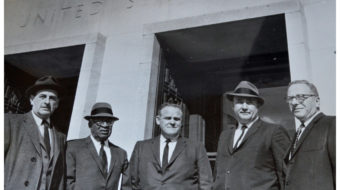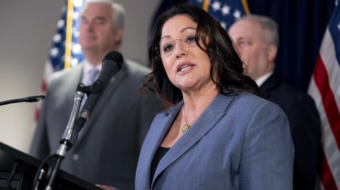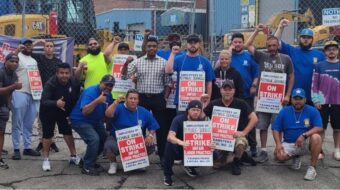
SEATTLE — A traveling exhibit, “Journey for Justice: 223 Years of Asian Pacific American History in the Puget Sound,” opened at the Wing Luke Asian Museum here Sept. 27 with its bold message that Asian Pacific American workers have won victories over racism and exploitation, yet continue to struggle for equality today.
Many of the workers whose photos and biographies are featured in the exhibit were present at the reception. Laurie Yamamura, a Japanese American postal worker, was there with her husband. She served as shop steward of her union local at the University of Washington post office before retiring in 2001. “This exhibit is fascinating,” she told the World. “It is part of my history. Stand up for your rights. That’s the lesson for me. That’s why I joined the union. If you help yourself, then you can help your fellow workers as well.”
Telling untold stories
Tracy Lai, president of the Seattle Chapter of the Asian Pacific American Labor Alliance (APALA), told the capacity crowd the exhibit has traveled widely since it was completed in 2004, displayed at the AFL-CIO headquarters in Washington, D.C., this summer, and displayed in Vancouver, British Columbia, during the Labor Day weekend. It created such an impression, she said, that the Canadian labor movement “wants to form a Canadian version of APALA.”
Ron Chew, director of the museum, said, “This exhibit … tells stories that have not been told, the struggle for justice. My father was a waiter paid $1 an hour, seven days a week, no vacation. My mother was a sweatshop worker. As a child, I watched people working literally until they died.” He announced that the museum is near to completing its $23 million fund drive for a new, much larger building where this unsung history will be featured.
Peter Kardas, director of the Labor Center at Evergreen College in Olympia, which helped produce the exhibit, said, “It reminds people of the repression and the racism and the anti-immigrant hysteria that has gone on for so long.”
The exhibit consists of photos of Asian American and Pacific Islander trade unionists active in the labor movement today with biographical sketches of their lives and struggles as union activists. The exhibit brings home just how rarely we see working people depicted as heroes in our mass culture, even though not a single wheel would turn without their work and every cupboard would be bare.
‘Make the history’
One of those featured is Tracy Lai, herself, a social studies professor at Seattle Central Community College. Lai is the president of American Federation of Teachers Local 1789 on her campus. “I teach about history,” she told an interviewer, “and one of the things that I emphasize with my students is when people are in those moments of making history, rarely do we know it. ‘Make the history,’ is what I say. Make the history.”
The exhibit provides a timeline called “milestones” that begins in 1780 with the arrival of Hawaiians in the Pacific Northwest working as seamen and stevedores for the Hudson Bay Company.
The Chinese Exclusion Act of 1882 and the mass internment of Japanese Americans during World War II are highlighted in the exhibit, which features many archival photographs and drawings.
Another worker pictured in the exhibit is Richard Gurtiza, a Filipino American, director of Region 37 of the Inland Boatmen’s Union in Seattle. An affiliate of the International Longshore and Warehouse Union (ILWU), Region 37 was once known as Local 37, representing the mostly Filipino cannery workers in Alaska and down the Pacific Coast.
“Sometimes even in the labor movement we are not recognized. We are not given a seat at the table,” Gurtiza told the World. “It is important to raise the consciousness of the role of Asian American workers in the labor movement.”
APALA and the exhibit, he said, can serve as a “bridge between the communities and the labor movement.”
Defending immigrants, defending the union
One of the milestones featured in the exhibit is the struggle to defend Local 37 leaders Ernesto Mangaoang and Chris Mensalves, both based in Seattle during a Cold War drive to deport them back to the Philippines in the late 1940s and early 1950s. The timeline makes clear it is revenge for their militant role in defending the cannery workers using their left-wing political beliefs as a pretext.
Among the staunchest defenders of the two union leaders was B.J. Mangaoang, wife of Ernesto. B.J., as she was affectionately known to her friends and family, served for many years as chairperson of the Communist Party USA in Washington state. She died Oct. 20 in Seattle at age 92.
The case, Mangaoang v. Boyd, went all the way to the U.S. Supreme Court, which ruled in 1953 that Mangaoang could not be deported under the Walter-McCarran Act.
“That was an era when everybody was being red-baited,” Gurtiza said. “They were trying to break the union. They tried to deport ILWU President Harry Bridges. They were not able to do it because the ILWU wielded such power on the docks.” Both Mangaoang and Bridges were well-known Marxists.
Against ‘race hatred’
The Bush administration is engaged in dragnet raids and mass deportations of immigrant workers today, Gurtiza added. “They are fanning the fires of fear and anxiety. They are using that fear as a means of control. All these immigrant workers want is to work, to get a fair wage so they can support their families.”
The exhibit points out that backward sections of labor joined in anti-immigrant witch-hunts that benefited only the bosses. Many workers, however, “were keen to the ways employers used immigrant and minority laborers to break strikes and weaken the power of organized labor,” the commentary explains.
The Industrial Workers of the World (IWW) and later the ILWU “vigilantly organized Asian workers into their ranks.”
Another milestone cited in the exhibit was the Seattle general strike of 1919. “For five days in February, 65,000 workers participated in a general strike in support of the city’s wartime shipyard workers,” the timeline states. The Seattle IWW issued an “Appeal to Japanese Workers in America.” One “Wobbly” wrote to a newspaper at the time, “Teaching race hatred has been the foundation rock on which the capitalists have been able to induce the workers to sanction and enlist in war. If we would allow every (Japanese worker) in our unions, that would solve the question.” He signed the letter, “Yours for one big union, with nobody that works barred no matter what his or her color, race, or creed.”
During the ensuing general strike, “the Japanese Labor Union formally endorsed and honored the strike” despite the continued exclusionary policies of many unions, the timeline reports.
Art Shields’ memoir, “On the Battle Lines, 1919-1939,” (published by International Publishers, New York) is quoted in the exhibit. Shields, later a staff writer for the Daily Worker, wrote, “The general strike was the first mass demonstration of interracial unity I had seen. The Black migration from the Deep South had not yet reached Seattle. But the Japanese colony went on strike with us. Seattle had 10,000 Japanese immigrants … any restaurants and hotels depended on them. The strike would have been weakened without them.”
Wartime internment
Another milestone is the unjust and shameful mass internment of Japanese Americans after Franklin Delano Roosevelt signed Executive Order 9066 in 1942. The timeline records that 120,000 Americans of Japanese descent were “forcibly removed from the Pacific Coast to inland ‘internment camps,’” on the bogus claim that they were “agents of the Japanese Empire.”
The exhibit features a photo of one of those detainees, Karl G. Yoneda, although he, his wife Elaine Black, and their son Tommy, were arrested in California. Yoneda, a leader of the Communist Party USA, was a legendary organizer of Asian American workers and a member of the ILWU.
Yoneda recorded his heroic exploits in his 1983 autobiography, “Ganbatte, Sixty-Year Struggle of a Kibei Worker,” published by the Asian American Studies Center at the University of California, Los Angeles. The AFT’s Human Rights and Community Relations Department published a beautiful poster of Karl Yoneda as part of its Asian Pacific American Labor Pioneers series, hailing him as “A champion for world peace and socialism.”
The APALA exhibit cites a major milestone in 1946 when Washington state citizens of Asian, African American and Hispanic ancestry began lobbying for the enactment of a Fair Employment Practices Act. “This is finally achieved in 1949,” the exhibit reads.
Yesterday and today
Today, globalized transnational capital is wreaking havoc in most of the developing world. A vast reserve army of labor, many of them forced from the land by the crisis in agriculture, is desperately seeking jobs to support their families, crossing borders seeking work in a strange land.
The parallels between the repression directed against immigrants today and that heaped upon immigrants 50 or 100 years ago is striking. Invariably, the bosses seek to inflame fear and to split, divide and confuse. Frightened people are easy to manipulate, their minds clouded so that they don’t see their common interest and their need for unity against a common foe.
The Japanese Labor Association summed it up in a letter to the Seattle General Strike Committee in February 1919, declaring that they had joined the strike. The letter deplored the AFL’s exclusion of Asian workers, adding, “If we laborers throughout the world have a similar position against the capitalists, no matter what jobs we occupy and what our nationality is, then there can be no borders for the laborers and we should do our duty in helping to win this fight.”
Tim Wheeler (greenerpastures21212 @yahoo.com) is national political correspondent for the People’s Weekly World.









